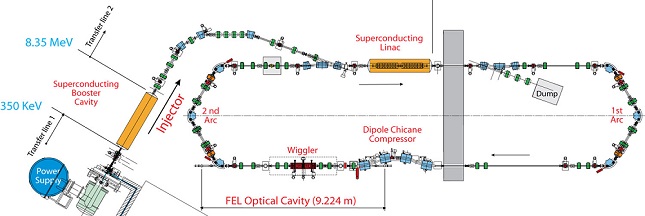ALICE
ALICE (Accelerators and Lasers In Combined Experiments) is an Energy Recovery Linac test accelerator at Daresbury Laboratory. High quality trains of bunches of electrons are produced by a DC photo-injector source. The electron bunches are then accelerated to around 30 MeV through two superconducting linacs. The electron bunches are then each compressed in a magnetic chicane to around 0.6 picoseconds, stimulating the production of intense pulses of coherent THz light. In addition the bunches are used to generate coherent infra-red radiation (typically 6 to 8 micron wavelength) in an oscillator FEL before passing through one of the linacs for a second time on the decelerating phase and so losing energy to the RF field which can then be used to accelerate subsequent bunches.
This unique facility is used to investigate and overcome the challenges presented to scientists in designing and building future generations of accelerators. This research is useful for both future light sources and other advanced accelerator development.
The intense light produced from ALICE has been used to carry out pilot experiments to study quantum dot solar cells and to develop new cancer diagnosis techniques. This has led to the award of a major grant from EPSRC in the UK to operate ALICE in a dedicated mode for part of the year for three years just for additional cancer studies using both the infra-red and THz light sources. This work is a major collaboration led by Liverpool University and includes several clinicians from research hospitals.
More information

